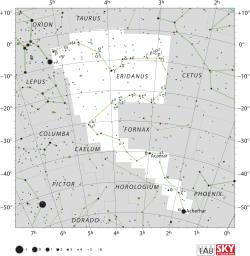Xi Eridani
| Xi Eridani (ξ) | |
 | |
| Observationsdata Epok: J2000.0 | |
|---|---|
| Stjärnbild | Eridanus |
| Rektascension | 04t 23m 40,85270s[1] |
| Deklination | -03° 44′ 43,6771″[1] |
| Skenbar magnitud () | +5,17[2] |
| Stjärntyp | |
| Spektraltyp | A2 V[3] |
| B–V | +0,08[2] |
| Astrometri | |
| Radialhastighet () | -11,0[4] km/s |
| Egenrörelse (µ) | RA: -47,36[1] mas/år Dek.: -54,91[1] mas/år |
| Parallax () | 15,60 ± 0,25[1] |
| Avstånd | 209 ± 3 lå (64 ± 1 pc) |
| Absolut magnitud () | +1,59[5] |
| Detaljer | |
| Massa | 2,29[6] M☉ |
| Radie | 2,2[7] R☉ |
| Luminositet | 27,6[8] L☉ |
| Temperatur | 8 400[8] K |
| Vinkelhastighet | 194,3 ± 2,3[3] km/s |
| Ålder | 450[6] miljoner år |
| Andra beteckningar | |
| ξ Eri, BD-04° 818, 42 Eridani, FK5 1120, HD 27861, HIP 20507, HR 1383, SAO 131176. [9] | |
Xi Eridani (ξ Eridani, förkortat Xi Eri, ξ Eri) som är stjärnans Bayerbeteckning, är en ensam stjärna[6] belägen i den norra delen av stjärnbilden Eridanus. Den har en skenbar magnitud på 5,17[2] och är svagt synlig för blotta ögat där ljusföroreningar ej förekommer. Baserat på parallaxmätning inom Hipparcosuppdraget på ca 15,6[1] mas, beräknas den befinna sig på ett avstånd på ca 209 ljusår (ca 64 parsek) från solen. Stjärnan anses vara medlem i Sirius superstjärnhop.[5]
Egenskaper
[redigera | redigera wikitext]Xi Eridani är en blåvit stjärna i huvudserien av spektralklass A2 V,[3] som anger att den genererar energi genom termonukleär fusion av väte till helium i dess kärna. Den har en massa som är ca 2,3[6] gånger större än solens massa, en radie som är ca 2,2[7] gånger större än solens och utsänder från dess fotosfär ca 28[8] gånger mera energi än solen vid en effektiv temperatur på ca 8 400[8] K.
Källor
[redigera | redigera wikitext]- Den här artikeln är helt eller delvis baserad på material från engelskspråkiga Wikipedia, tidigare version.
Referenser
[redigera | redigera wikitext]- ^ [a b c d e f] van Leeuwen, F. (2007), "Validation of the new Hipparcos reduction", Astronomy and Astrophysics, 474 (2): 653–664, arXiv:0708.1752 , Bibcode:2007A&A...474..653V, doi:10.1051/0004-6361:20078357.
- ^ [a b c] Mermilliod, J.-C. (1986), "Compilation of Eggen's UBV data, transformed to UBV (unpublished)", SIMBAD, Bibcode:1986EgUBV........0M.
- ^ [a b c] Díaz, C. G.; et al. (July 2011), "Accurate stellar rotational velocities using the Fourier transform of the cross correlation maximum", Astronomy & Astrophysics, 531: A143, arXiv:1012.4858 , Bibcode:2011A&A...531A.143D, doi:10.1051/0004-6361/201016386.
- ^ Wielen, R.; et al. (1999), Sixth Catalogue of Fundamental Stars (FK6). Part I. Basic fundamental stars with direct solutions, 35, Veröffentlichungen des Astronomisches Rechen-Institut Heidelberg, Bibcode:1999VeARI..35....1W.
- ^ [a b] Eggen, Olin J. (August 1998), "The Sirius Supercluster and Missing Mass near the Sun", The Astronomical Journal, 116 (2): 782–788, Bibcode:1998AJ....116..782E, doi:10.1086/300465.
- ^ [a b c d] De Rosa, R. J.; et al. (January 2014), "The VAST Survey – III. The multiplicity of A-type stars within 75 pc", Monthly Notices of the Royal Astronomical Society, 437 (2): 1216–1240, arXiv:1311.7141 , Bibcode:2014MNRAS.437.1216D, doi:10.1093/mnras/stt1932.
- ^ [a b] Pasinetti Fracassini, L. E.; et al. (February 2001), "Catalogue of Apparent Diameters and Absolute Radii of Stars (CADARS) – Third edition – Comments and statistics", Astronomy and Astrophysics, 367 (2): 521–524, arXiv:astro-ph/0012289 , Bibcode:2001A&A...367..521P, doi:10.1051/0004-6361:20000451.
- ^ [a b c d] McDonald, I.; et al. (2012), "Fundamental Parameters and Infrared Excesses of Hipparcos Stars", Monthly Notices of the Royal Astronomical Society, 427 (1): 343–57, arXiv:1208.2037 , Bibcode:2012MNRAS.427..343M, doi:10.1111/j.1365-2966.2012.21873.x.
- ^ "* ksi Eri". SIMBAD. Centre de données astronomiques de Strasbourg. Hämtad 2016-11-03.





